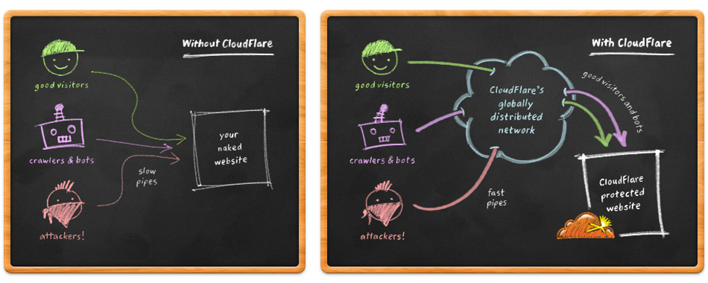Introduction to Cloudflare
Updated on Sep 4, 2024
Cloudflare became publically available as a service during the second half of 2010 at the prestigious TechCrunch Disrupt conference. The CEO Matthew Prince announced that Cloudflare will be available to everyone who wants to have a fast and secure website without any additional work necessary to its code or functionality.
The core purpose of the service is to protect and accelerate every website using it. As long as the user adds a domain to the Cloudflare service the website under that domain immediately becomes part of a big and intelligent global network. In this network the website's content is distributed across a large amount of data centers Cloudflare uses. This allows websites to load quickly for users worldwide, no matter where it is hosted.

For example if a website is hosted in Chicago USA and the users accessing it are mainly from Europe, Cloudflare will help the website load as quickly as if it was hosted in Europe. Additionally when a website is under the Cloudflare global network it is immediately protected from a large variety of malicious attacks and known vulnerabilities which can severely harm a website.
Cloudflare can be used by anyone. From System Administrators to website owners, everyone can use the service. All that is necessary is for the DNS records of the domain to point to Cloudflare's Nameservers. No hardware or code changes are required.
The core functionality of the service is absolutely free for everyone. Of course there are paid services Cloudflare provides. However, they are not mandatory and are more suitable for users who are looking for specific functionalities, security features or analytics that the free plan does not provide. Cloudflare's main features, the ones included in its free plan, are quite handy and we have broken the most significant ones down for you.
- Cloudflare CDN -The main offering from Cloudflare. The abbreviation CDN stands for "Content Delivery Network." It means that the static contents of your websites, such as CSS and HTML files, are distributed across several locations around the globe so whenever a user from a distant location loads your website the loading speed will as fast as if they were opening a local website;
- Cloudflare Optimizer - Sometimes it is not enough for your website to be delivered more promptly to visitors. In such cases Cloudflare offers additional optimization services based on their famous Rocket Loader or by reducing the amount of connections your website performs;
- Cloudflare Security - Cloudflare implements an outstanding security layer without even touching the code of your website. This incredible service is achieved on a web request level and many other additional security Features. With even the basic free plan you are protecting your website from nearly 90% to the known vulnerabilities and exploits. Cloudflare can monitor and filter the traffic moving through your website, ensuring only good, legitimate connections are let through;
- Cloudflare Analytics - Would you like to be able to review all the traffic coming to your website? That is possible with the analytics services Cloudflare provides to all of its users. With them you will be able to see how much bandwidth Cloudflare is saving you many other statistics.
Cloudflare is free for all and in this tutorial series we will provide you with detailed information on how to use it and how to benefit the most from the features it offers.

CDN Hosting
- Free Domain Transfer
- 24/7 Technical Support
- Fast SSD Storage
- Hack-free Protection
- Free Script Installation
- Free Website Transfer
- Free Cloudflare CDN
- Immediate Activation
